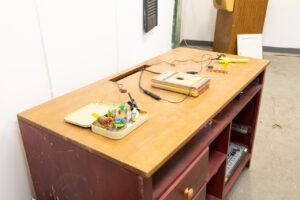Before the DJ Was Sound, and She Played It
Petra Floyd (2022)Before the DJ Was Sound, and She Played It, is a constellation of three interdisciplinary projects by Petra Floyd: Five Factors 3, Electric Boogie Revolution, and Kalimbrrd. Exhibited together, these sculptural installations are explicit invitations to experience sound and movement as inherited technologies for orienting ourselves in unknowable space/times by listening to music, playing hand instruments, and doing a little line dancing.


Kalimbrrd features a handmade, amplified thumb piano (kalimba) and noisemakers for viewers to play and reshape the exhibition’s soundscape. Electric Boogie Revolution asks viewers to perform a timewarped “Electric Slide” from audio instructions; if viewers choose to dance, a visual score will emerge in the sand under their feet. Kalimbrrd and Electric Boogie Revolution are nestled within and anchored by Five Factors 3, a five-channel television and furniture installation featuring video of Naeem Martinez White, a local Pittsburgh visual and sonic artist, and myself communicating across different spaces and times (Pittsburgh and New Mexico) with acoustic and kinetic gestures.


Floyd defines inherited technologies as invented or observed tools, instructions (algorithms), or concepts that can be used to interact with other beings and environments. Tech is not just touch screens, data servers, and drones. Textiles are algorithmically constructed interfaces between the body and the environment: generated by a weaver or a machine from a finite set of instructions, they protect our skin from injury, maintain our body temperature, store useful materials or tools, and communicate information about our identity, personal history, class, and cultural affiliation. Textile design and production knowledge is passed down generationally, inherited and modified by subsequent generations to meet their needs. Songs and dances operate similarly as social technologies and open-ended improvisational structures. These modes blend inherited instructions (scores) and variable inputs from dancers/watchers and players/listeners (improvisation) with semantic meaning (lyrics), meta-information (style or genre), and timecodes (tempo and time signatures).
By taking the time to slow down and expand our shared understanding of “tech,” Floyd seeks to scramble or dislodge Western epistemologies (systems of knowledge) that delegitimize non-European, historical ones. Our common idea of “technology” is wrapped up in an obsession with future-oriented progress, advancement, expansion, and discovery that is supported with the precarious extraction of labor, energy, and other resources from colonized people, animals, and environments. In times of uncertainty, imbalance, and incompatibility, Floyd uses music and movement to reorient herself and reintegrate with the dense ancestral expressions within them. Call it emotional regulation for uncertain space/times.
This project is inspired by Sankofa, a gift from the Akan people in Ghana, an Adinkra ideogram (symbolic picture) of a bird in profile with its neck turned as it reaches for an egg on its back. This ideogram commands, “Go back and fetch it.” To move into the future, one needs to reach into the past. Floyd delights in following the cyclical, looping transits of concepts and materials throughout Before the DJ. She hopes you do too.
Before the DJ has been installed at the Miller Institute for Contemporary Art at Carnegie Mellon University in Pittsburgh, PA and Fjord Gallery in Philadelphia, PA.
This project was made possible in part by support of the Frank-Ratchye STUDIO for Creative Inquiry and the Frank-Ratchye Further Fund Grant #2022-042. Additional images are available here.




